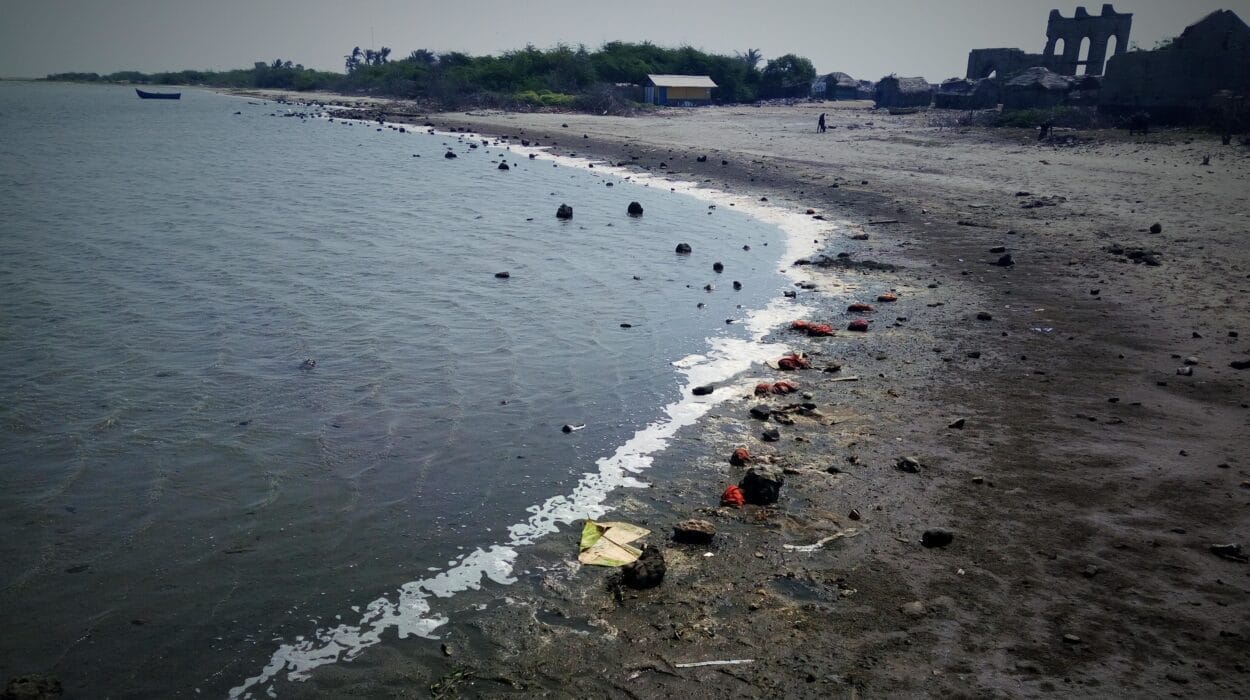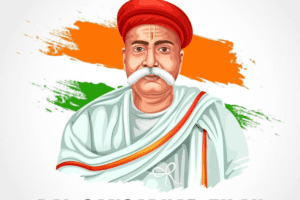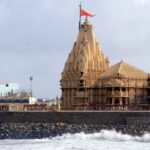Small island town Rameswaram, on India’s southern tip, is steeped in Hindu mythology and religious significance. Rameswaram is a popular pilgrimage destination because of its magnificent Ramanathaswamy Temple, one of the twelve Jyotirlinga shrines dedicated to Lord Shiva. Dhanushkodi, a haunted town with an eerie beauty and a tragic past, is located on the island’s eastern coast. In 1964, a devastating cyclone completely destroyed the once-thriving town of Dhanushkodi, leaving only ruins and recollections of the past. Even though the town is no longer inhabited, it still holds a lot of significance and draws people from all over the world. We will take you on a journey through the significance and history of Dhanushkodi, Rameswaram’s ghost town, in this blog.
The Cyclone and Destruction
The town of Dhanushkodi on the southern tip of Rameswaram island was completely destroyed on December 22, 1964, when a powerful cyclone struck. The storm surge caused by the cyclone, which had winds of up to 240 kilometers per hour, swept through the town and destroyed everything in its path. The extent of the damage was such that the town was deemed uninhabitable and was abandoned.

A passenger train, several houses, and a railway line connecting Dhanushkodi to the mainland were also washed away by the cyclone’s storm surge. The disaster claimed the lives of over 1800 people and destroyed the town. Only the Kothandaramaswamy Temple was left standing after the railway station, schools, hospitals, and St. Antony’s Church were all destroyed.
One of India’s worst natural disasters at the time was the Dhanushkodi railway disaster, as it came to be known. The town was completely destroyed, leaving only recollections and ruins of the past. Dhanushkodi was declared a “ghost town” by the Indian government, and it was forbidden to rebuild. As a result, the town has never been inhabited.

The tragic incident serves as a reminder of the destructive power of the natural world and the significance of being prepared for disasters. Dhanushkodi is still a popular tourist destination and a popular Hindu pilgrimage site despite the destruction. Visitors can see the town’s ruins and learn about the town’s long history.
The Significance of Dhanushkodi
Dhanushkodi holds a lot of religious and historical significance for Hindus, despite its tragic past. It is a significant place of pilgrimage due to the town’s proximity to Rameswaram and the Ramanathaswamy Temple, one of the twelve Jyotirlinga shrines dedicated to Lord Shiva. It is believed that Lord Rama built a bridge across the sea at this temple, which is one of India’s most popular pilgrimage destinations, to save his wife Sita from the demon king Ravana. It is believed that Lord Hanuman and his army of monkeys assisted in the construction of this bridge, which is also known as Rama Sethu or Adam’s Bridge.

Dhanushkodi is also thought to be the southernmost point of Rameswaram island and the Indian mainland. It is also thought that Lord Rama himself gave it a blessing. The name Dhanushkodi, which translates to “the end of the bow,” is derived from the legend that Lord Rama broke one of his arrows (called Dhanush in Hindi) in order to construct the bridge across the sea.
The Kothandaramaswamy Temple, the St. Antony’s Church, and the Dhanushkodi railway station’s ruins all serve as a reminder of the town’s tragic past and rich history. The temple is a symbol of the town’s resilience in the face of disaster because it is thought to be the only structure that survived the cyclone.

Dhanushkodi has become a popular tourist destination for history, religion, and natural beauty enthusiasts in recent years. The town’s scenic beauty, which includes the Indian Ocean and the Bay of Bengal, makes it a great place to take pictures and go sightseeing. Visitors also frequent the Dhanushkodi beach, where they can take a tranquil stroll along the shore and take in the breathtaking views of the sea.
Despite its tragic past, Dhanushkodi is a symbol of the human spirit’s resilience in the face of adversity and holds a special place in the hearts of Hindus and visitors alike.
Visiting Dhanushkodi
Dhanushkodi is accessible by road and rail from the southern tip of Rameswaram island. Rameswaram is the closest railway station, and it has train connections to major Indian cities. Dhanushkodi, about 18 kilometers away, can be reached by bus or taxi from Rameswaram.

The ruins of Dhanushkodi offer visitors a chance to learn about the town’s long and illustrious past. Visitors should not miss the Kothandaramaswamy Temple, which is the only structure from the 1964 cyclone that is still standing. The sage Vibhishana, king of Lanka, who later assisted Lord Rama in his war against Ravana, is said to have met Lord Rama and his brother Lakshmana at this temple, which is dedicated to him.

Additionally, popular attractions include the Dhanushkodi beach, the church of St. Antony, and the ruins of the Dhanushkodi railway station. The Adam’s Bridge or Rama Sethu, the bridge that is believed to have been constructed by Lord Rama and his army of monkeys to rescue his wife Sita, can also be seen on a boat ride to the nearby island of Arichalmunai.

It’s important to remember that Dhanushkodi is an uninhabited town with no places to eat or stay. Rameswaram can be dangerous after dark, so visitors are advised to bring enough food and water with them and return to the town before sunset.

It’s also important to remember that Dhanushkodi reconstruction has been outlawed by the Indian government. Visitors are asked to respect the town’s history and not damage any of the buildings that are still standing.

Dhanushkodi is a one-of-a-kind and fascinating location that gives visitors a glimpse into the town’s fascinating past and natural beauty. People who are interested in history, religion, and natural beauty should go there.
Best Time to Visit
The kind of experience you’re looking for will determine when you should visit Dhanushkodi. The best time to visit is in the winter, from October to February, if you want to stay cool. During this time, the temperature is pleasant, making it ideal for exploring the town and its surroundings.

The monsoon season, which runs from June to September, might be the best time to visit if you’re into photography. The rough sea and the lush green landscape are great places to take beautiful, one-of-a-kind pictures.
However, visitors should check the weather forecast and take the necessary precautions because the monsoon season coincides with cyclone season in the region.

In general, you should avoid Dhanushkodi during the summer months of March to May because the heat and humidity can make it hard to see the town.
It is essential to keep in mind that Dhanushkodi is a relatively remote location with limited facilities. Rameswaram can be dangerous after dark, so visitors should bring plenty of food and water with them and return before sunset.
Conclusion
In conclusion, Dhanushkodi is a one-of-a-kind location that Hindus consider to be of significant historical and religious significance. The town is a popular destination for pilgrims due to its proximity to the Ramanathaswamy Temple, one of the twelve Jyotirlinga shrines dedicated to Lord Shiva. The remains of the town as well as the Kothandaramaswamy Temple are a reminder of the human spirit’s resilience in the face of adversity, despite the cyclone’s tragic destruction in 1964. While taking in the picturesque views of the Bay of Bengal and the Indian Ocean, visitors to Dhanushkodi can learn about the town’s long history by exploring its ruins. However, it is essential to keep in mind that Dhanushkodi is a deserted town, so visitors should take the necessary precautions, such as bringing plenty of water and food with them and returning to Rameswaram before dusk. In a nutshell, a trip to Dhanushkodi is an unforgettable, fascinating, and one-of-a-kind experience.












